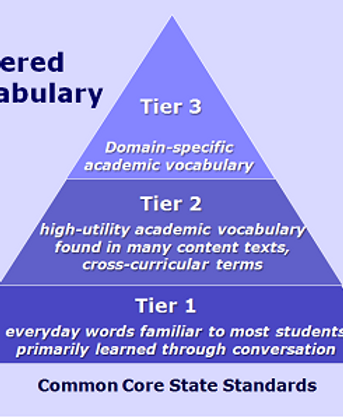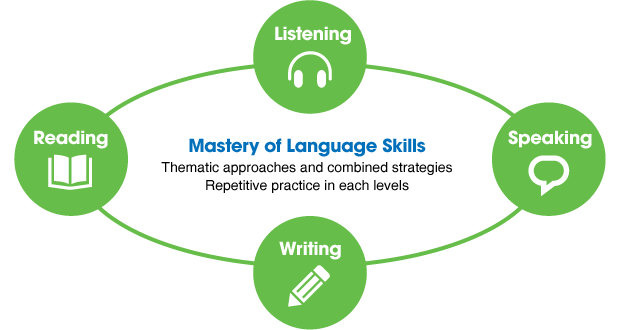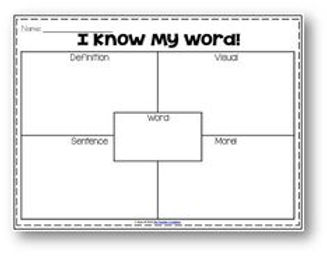Tara Bauman

Vocabulary Content Knowledge Summary
Vocabulary is the words of a language. Children start to learn vocabulary at a very young age. The earliest signs of hearing vocabulary are in the womb and as children grow, they learn more and more. Children learn the most of their vocabulary from 0-5. As parents and teachers introduce new vocabulary, students start to recognize new words. Marzano developed six steps for teaching vocabulary which are: Describe, restate, representations, activities, discussion, and games. Through these steps, students are to be able to understand new terms. Vocabulary words also come in three different tiers. The first tier is common words that someone would use every day. The second tier is more academic vocabulary and have more technical meanings. Lastly, tier three is domain specific and is used for understanding specific concepts. Understanding vocabulary is important for word recognition and to support comprehension when reading.

Vocabulary Terms
Vocabulary: The words of a language
Synonyms: Words that mean the same as another word. Example: strong and forceful.
Antonyms: Words that have opposite meanings. Example: tall and short.
Homophones: Words that sound the same but are spelled different. Example: to, too, two.
Homographs: Words that are spelled the same but are said differently. Examples: read and read.
Homonyms: words that spelled the same but have different means. Example: park the car or play in the park.
Root Words: base of the word
Affixes: both prefix and suffix. Prefixes are before the word while suffixes come after the word. Examples of prefixes: pre, un, re. Example of a suffix would be like the ending -ed.
Onomatopoeia: words that makes sounds. Examples: Boom, Buzz, Drop.
Euphemisms: A substitute word for something that is to harsh to use. Example: Passed away.

Marzano's 6 Steps of Vocabulary
Step 1: Describe- Provide students with a descriptions, explanation or example (not definition)
- Determine prior knowledge
- What do you think you know about this term?
- Use imagery
Step 2: Restate- Student restate the description, explanation or example in their own words
- Discuss with a partner
- Student records
Step 3: Representations- Students represent the term non-linguistically
- Graphic representation illustrating process
- Draw it
- Draw a symbol
- Dramatize the term
- Student record
Step 4: Activities- Engage students periodically in activities that add to their knowledge of the terms
- Identify synonym and antonyms
- Listed related words
- Clear up common confusion
- Write metaphors and analogies
- Classify Terms
- Student record
Step 5: Discuss - Ask students to discuss terms with each other
- Think-Pair-Share about targeted terms
- 2 minute vocabulary buzz
- Add to or revise student record
Step 6: Games - Play games with your terms
- Jeopardy
- Pyramid
- I have, who has?

Vocabulary Tiers
Tier 1: Common, known, everyday words
- Important for EL students
- Learned by hearing family, peers, and teachers use them when speaking
- Examples: school, family, chair
Tier 2: Academic vocabulary, cross- curricular terms
- Need to know technical meanings and connotative meanings
- Important for reading comprehension
- Examples: Predict, summarize, explain
Tier 3: Domain specific academic vocabulary
- Used in text or lecture to help understand concepts
- Examples: arithmetic, solar system, anomaly

Vocabulary Categories
Listening: the terms and phrases that an individual understands when someone is speaking to them.
Speaking: the terms an individual uses when speaking
Reading: the terms that individuals recognizes and understands when reading
Writing: the terms an individual uses when writing

Artifact
I would hand this to my students to fill in the blanks to learn vocabulary words. They start by filing the word in the center and then define it, use it in a sentence, synonyms, antonyms, and then lastly draw a picture.
Vocabulary Instrucional Strategies
Word Wall
Use a word wall to build and expand vocabulary. Each week teacher will put words up on the word wall that students can either review or learn new. Throughout the week be using words and refer back to the word wall so students become comfortable with new words. Teacher will switch words each week.
Vocab Journals
This strategy comes from Marzano’s Six Steps. Use strategy by having students write in their journals the definition of a word, definition in their own words, an example, a picture, and a connection or game that will help them create meaning of the word. Each student would have their own vocabulary journal.
Stick to Your Story
When reading a story, have students think about what is happening and come up with a definition for the word they may be struggling with. Use the context of the story to correlate definition and how it is used in the story. Have students go back and explain the word in a different scenario to show understand of the word.
Be word conscious
This strategy is particularly helpful for students who are reading on their own. Have students keep track of their understanding of words. Have them ask themselves, “Do I know this word?” or “Do I know how this word is being use?” If students do not understand, have them come up with individualized ways they are going to determine the word.
Use a reference and explain it!
Have students look up definitions using outside resources such as internet or dictionary. After students look up the definition, students should refer back to the text and look how it is being used. Choose the correct definition for the text and explain what the word means in student’s own words to show comprehension and understanding of definition.
Vocabulary Website and Applications
Wordhippo.com Is a wonderful website that allows you to find synonyms and antonyms of words. I would use this website when my students do their word journals and need help coming up similar or different meanings. The students can use this as a tool outside of the classroom to expand their vocabulary.

Alphabet organizer
In this app, students are able to create list of words that they can have a separate page for. On the separate page they can display an image for a word, a description, or come up with their own definition which, can help with student vocabulary.

Big Bird Words
This app uses the camera on the device to take pictures of things in the environment so students can find words that are unfamiliar to them and identify them with this app. Big bird words is a great way for students to learn new words in a fun way but also it is important to see the pictures they are taking by closely monitoring them.

Bluster!
Bluster is an app that allows students to play individually or with a team. This app has students matching as many words while racing the weather and time. One benefit of this app is that there are three different levels for students to play. Bluster can be played with students of multiple age levels and advancements.